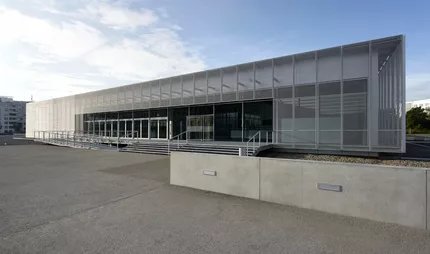
Four Power Status and Reconstruction of Berlins (1945-1950s)
Four sector city
At the Yalta Conference held in February 1945, the Allies divided Berlin into four sectors – France controlled the north-western, England the western and the USA the south-western parts of the city, while the whole of the eastern part of Berlin was allocated to the Soviet Union. The Magistrate (City Council) set up initially by the Soviet City Commandantura with Arthur Werner as Mayor soon had to relinquish its place, following the first election to the “Greater Berlin City Council”, to an SPD Government under Otto Ostrowski (SPD). The increasing tensions between the victorious powers soon led to the emergence of the “Cold War”, which affected the entire world, but particularly Berlin at the micro level.
Blockade and Airlift
The attempt by the Soviet Union to bind the western sectors of Berlin to economic supplies through East Berlin and the Soviet controlled surrounding countryside by means of a rail and road blockade, failed due to the “airlift”. In order to supply and support the Berliners as well as their own troops stationed in the western sectors, in the period from June 1948 to May 1949 the American and English Air Forces flew in approx. 2.34 million tons of coal, food and construction materials via Tempelhof and Tegel airports as well as the Berlin lakes.
Mayor of Berlin
The city councillor Ernst Reuter (SPD) made a strong impression on the population and Western Allies as a symbol of Berlin’s spirit of resistance against Soviet efforts at annexation. His 9th September 1948 speech addressed to the “peoples of the world” was avidly followed by an estimated 300,000 people in front of the Reichstag. Only three months later, Ernst Reuter was elected Mayor of West Berlin with an absolute majority. Five days beforehand on 30th November, the political division of Berlin had taken place. In East Berlin, the Socialist Unity Party (SED) had forced the dismissal of the Magistrate, whereupon Friedrich Ebert, son of the first Reich President, was elected Mayor of Berlin. The scope of his ambit was, however, restricted by the Western military authorities to the eastern (communist) sector.
Issue of the Capital
Both the constitution of the Federal Republic of Germany (West Germany) from 23rd May 1949 and that of the German Democratic Republic (East Germany) from 7th October 1949 laid claim to Greater Berlin. The special Allied status for West Berlin remained in force until German reunification in 1990. The provisional capital of West Germany and seat of government was Bonn. East Berlin became the capital of East Germany.
Development of the city in East and West Berlin
The city planner Hans Scharoun, entrusted with the development of a reconstruction of the badly damaged city by the Soviet military government in 1945, was a visionary. The plans he presented in 1946 envisaged the near complete razing to the ground of the building structures still standing and the division of the city into functional zones. Instead of which, however, the East German regime decided to adopt the “sixteen principles of urban development”, demolished the historic Berlin Stadtschloss (City Palace) in favour of a demonstration square, and, starting in 1951, constructed neoclassical buildings along Stalinallee (today’s Karl-Marx Allee) to create the “first socialist boulevard” in the country. In West Berlin, the area between Zoologischer Garten, Kurfürstendamm and Ernst-Reuter Platz was developed into a new city centre for commerce, administration and culture. In 1957, the International Building Exhibition (Interbau), in cooperation with world-renowned architects such as Le Cobusier, Oscar Niemeyer, Walter Gropius, presented the buildings erected in the Hansa Quarter as well as the Kongresshalle (Congress Hall) in Greater Tiergarten. The one hundred thousandth apartment in West Berlin constructed with state funding was delivered on 21st June 1957.
17th June Uprising
On 16th June 1953 in the district of Friedrichshain, East Berlin building workers went on strike in protest against the raising of work norms decreed by the East German regime. This immediately turned into a popular uprising, which erupted on 17th June in the form of demonstrations and protests throughout the whole country, to demand the resignation of the Government and the taking place of new elections. The East German leadership fled to the Soviet military authorities in Berlin-Karlshorst. The Soviets then decreed a state of emergency and crushed the uprising by military force using tanks, 20,000 soldiers and 8,000 members of the East German Kasernierte Volkspolizei (Barracked People’s Police). The day of 17th June, declared as the “Tag der deutschen Einheit” (Day of German Unity) by the West German Parliament on 4th August, claimed at least 55 lives. It was followed by waves of arrests and criminal prosecutions resulting in many cases in the death penalty or long prison sentences in forced labour camps.



